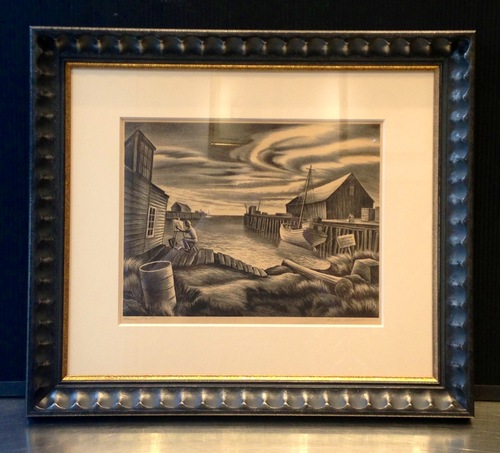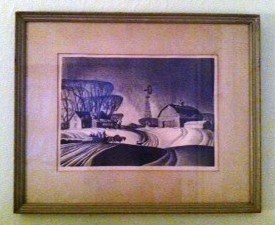What Framing can do for your piece: 1940 to 2013
Sometimes a piece of art just needs a makeover. Recently, we framed a lithograph that was was funded by the Works Progress Administration, which was part of FDR’s New Deal program. This particular piece was originally framed in a set and purchased sometime in the late forties. For decades, the pieces resided at different households in twin frame designs until one of them made it’s way over to us for repair. This “before” photo shows the sister piece, which remains in its original frame.
Not only was this litho in need of an aesthetic update, but the non-archival material encasing it for so many years had caused the paper to turn yellow. Yellowing is caused by an acid called lignin (which naturally occurs in wood) as it reacts to air and sunlight. As the process of discoloration progresses, the paper becomes brittle and eventually crumbles. That’s why using acid-free mats and UV-protected glass is so important. No matter how far the deterioration process has progressed, these materials will stop it in its tracks!
We chose a unique commercial moulding with a silvery-black finish and a scalloped shape. The variation in the black finish brings out the subtleties in the lithograph’s tones, while the organic shapes in the moulding itself highlight the swirling patterns in the image’s moody sky. The mat we chose was a slightly brownish clay tone—a few shades lighter than the paper—but not so white as to call attention to the yellowness. These choices meshed well but there was still something missing, some detail needed to pull all the elements together. This situation called for a fillet! A fillet is a thin lip of moulding that sits inside the opening of the frame. A fillet is a handy way to add detail to a frame that needs just a little something extra. The touch of gold added a warm glow to the whole piece, and gave it a more vintage and regal look, placing it in the time period in which it was made, without making it looked “dated”.
Framing can have a dramatic effect on a work of art—both in how it will be perceived by a viewer, and how well it will hold up over the years. Each detail counts towards the overall finished product, and sometimes the smallest element—a fillet for example—can make all the difference.

